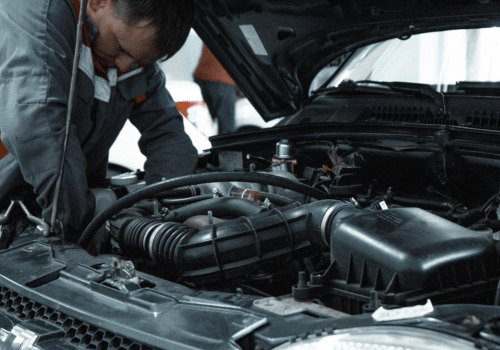Coolant Leak Symptoms: A Comprehensive Guide

Have you ever noticed a mysterious puddle under your car or a strange, sweet smell when you pop the hood? These could be telltale signs of a coolant leak , a common yet serious issue that could jeopardize your vehicle’s performance and engine life.
Identifying such symptoms early on is key to preventing costly repairs and potential breakdowns. In this guide, we’ll explore various indicators of both external and internal coolant leaks, helping you pinpoint and address these issues effectively.
We’ll discuss how to accurately locate the source of the leak, which might not be as straightforward as you think.
RECOGNIZING COOLANT LEAK SIGNS
Spotting the signs of a coolant leak early can save you from costly repairs and engine damage. Keep an eye out for colorful puddles under your car and a distinct sweet smell emanating from the engine bay. These are classic coolant leak symptoms.
If you notice your engine overheating, act quickly. Early detection is key to prevent engine damage and maintain your ride’s health.
SYMPTOMS OF EXTERNAL LEAKS
If you notice visible puddles or stains beneath your vehicle, it’s likely you’re dealing with an external coolant leak.
- Visible puddles indicating the color of fluid
- Staining on engine components suggesting a minor leak
- Low coolant levels in your car’s system
- Sweet smell coming from the engine compartment
INDICATORS OF INTERNAL LEAKS
You might notice white smoke from your exhaust, which is a common indicator of an internal coolant leak. This issue often stems from coolant mixing with oil, threatening your internal engine and head gasket.
You might also experience rough idle or lumpy running. A professional using a gas analyzer can confirm these signs. Address these symptoms with prompt repair to avoid severe engine damage.
LOCATING THE COOLANT LEAK
Once you’ve noticed signs of a coolant leak, it’s essential to pinpoint its origin. Start by visually inspecting all hoses, connections, and the radiator for any obvious signs of leakage.
These steps can help guarantee you’re tackling the right problem before moving on to more detailed diagnostic tests.
IDENTIFYING LEAK SOURCES
To locate a coolant leak, start with a visual inspection of hoses, connections, the radiator, water pump, and gaskets.
- Check for signs of wear on all cooling system components.
- Conduct a pressure test to locate the source of hidden leaks.
- Seek professional assistance for complex issues like a gasket leak.
- Watch for a sweet odor, indicating a leak into the combustion chamber.
VISUAL INSPECTION TIPS
Start by looking for wet spots, stains, or puddles beneath your car, as these often indicate a coolant leak. Then, inspect hoses, connections, and the radiator in your engine bay.
Don’t forget the water pump and other cooling system components. If you can’t spot the leakage, a pressure test might help.
REPAIRING COMMON LEAK SOURCES
When dealing with common coolant leaks, it’s crucial to first inspect and repair or replace damaged hoses, tighten clamps, and address radiator issues with appropriate stop leak products.
Here’s your checklist:
- Replace any damaged hoses
- Tighten all clamps securely
- Use stop leak products for minor radiator leaks
- Seek professional help for water pump or gasket issues
You’re not alone in this—let’s keep your engine safe together!
SEALING TECHNIQUES FOR LEAKS
You can quickly address small coolant leaks using specialized sealing techniques, such as stop leak products that effectively plug holes and cracks in your cooling system. Remember, following the manufacturer’s instructions guarantees the best results.
This quick solution isn’t only cost-effective but also keeps your cooling system running efficiently between regular maintenance checks. You’re part of a smart community opting for such savvy fixes!
PREVENTIVE MAINTENANCE STRATEGIES
While sealing techniques offer temporary fixes, establishing a routine of preventive maintenance strategies will guarantee long-term health for your cooling system.
- Regular Inspections: Frequently check cooling system components to prevent coolant leaks.
- Coolant Replacement: Follow manufacturer’s guidelines to maintain peak engine temperature.
- Professional Assistance: Seek expert help for complex issues. Use Radiator Leak Coolant Additives: Seal small cracks effectively.
ESSENTIAL TOOLS FOR LEAK DETECTION
What’s one indispensable tool for pinpointing elusive coolant leaks in your vehicle?
A coolant pressure tester is your go-to gadget. It’s essential for detecting small leaks and simulating the running engine effect, making even hidden external leaks visible.
By identifying internal coolant leaks early, you’ll avoid serious engine damage. Join the savvy car owners who keep this tool handy for effective leak detection.
WHEN TO SEEK PROFESSIONAL HELP
Although a coolant pressure tester is handy for initial checks, certain symptoms demand professional expertise.
Here’s when you should consider seeking professional help:
- White smoke from the exhaust, indicating internal coolant leaks
- Lumpy running or rough idle, signs of a head gasket leak
- Coolant mixed with oil, a serious issue needing immediate attention
- A gas analyzer test to confirm suspicions of internal leaks
ENHANCING COOLANT SYSTEM LONGEVITY
To enhance your vehicle’s coolant system longevity, regular system inspections are essential. By investing in high-quality coolant products and adhering to manufacturer recommendations, you’re part of a community dedicated to preventing future engine damage.
Fixing coolant leaks early, recognizing common signs, and maintaining your cooling system can save you from costly repairs. Let’s stay vigilant together with regular coolant inspections to protect our rides.
CONCLUSION
So, you’ve mastered the signs and symptoms of a coolant leak, but what’s next? Why not take proactive steps to safeguard your vehicle’s health?
Regularly check your coolant levels, inspect hoses and connections, and don’t hesitate to consult a professional if things seem off.
By staying vigilant and well-prepared, you guarantee your car’s longevity and performance. For any questions about auto repair, you can call HM Motorworks at (603) 881-7755!
The post
Coolant Leak Symptoms: A Comprehensive Guide appeared first on HM Motor Works.

